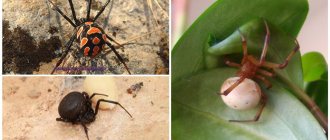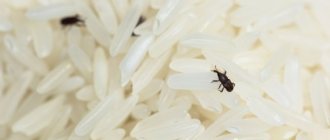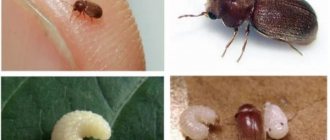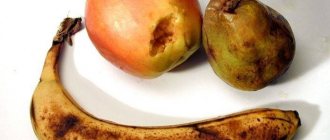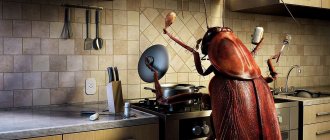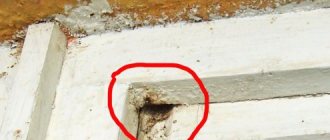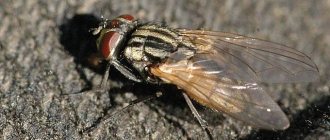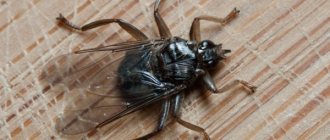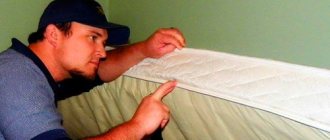Who is he
If you have at least once encountered a small black or brown bug in your apartment, and more than one, you should definitely read this article carefully. It is likely that a leather beetle has settled in your house. If, having heard its name, you decided that this small insect feeds exclusively on skin, then you are very mistaken. Unfortunately, there are very few things that are inedible for these nasty insects. Glue, fabric, cardboard, food products - this is a long list of “goodies” that such bugs will be happy to try. With the same success, they will not disdain products made of wood, plastic and even concrete. Therefore, if you suddenly find such a “little animal” in your home, you need to get rid of it urgently.
Grinders
Furniture
Small brown bugs on a windowsill made of wood may turn out to be furniture grinders that have left their hiding places in the wood. The adult size is 2.7-4.5 mm. The body is cylindrical, elongated. There are 10 clearly visible grooves on the elytra. The body is covered with sparse light bristles.
The adult lives only 6-28 days. As adults, the bugs do not feed; their only goal is to leave offspring. The wood is eaten by larvae, which gnaw holes in it and pupate there.
Brownie
This beetle is unlikely to appear in an apartment, as it prefers frost-damaged wood. But residents of wooden private houses should be wary of it. Compared to other domestic parasites, this is a large insect: 4-7 mm. The color is dark gray with a brown tint. On the sides of the pronotum there are spots of golden bristles.
Weevils and borers
Development and reproduction
To understand how long it can take to combat these pests, let's look at the stages of development of the leather beetle. Females can lay their larvae anywhere: on the surface of various materials, in cracks in the floor and walls, in furniture, and so on.
Depending on the room temperature, the period for the birth of a new population can range from two to fifty days. The drier and warmer the room, the faster the process goes. Each female is capable of laying about a hundred eggs during her life, and under the temperature and humidity conditions of an apartment, leather beetles can produce 4-5 offspring per year.
The larva of the leather beetle molts 6-7 times with an interval of 5-9 days, and before the pupation stage it can gnaw out long (up to 10 cm) passages even in those materials that are not used for food. Thus, it is the larvae that cause the greatest damage to the premises and people.
Another type of weevil
Another common type of weevil is the rice weevil, which is just as dangerous to food as the grain weevil. It is a brown bug, three to four millimeters long. It has small wings and a lighter color than the granary weevil.
He also eats almost all types of cereals, grains and beans, and even eats tobacco found in cigarettes. In the apartment, rice weevils settle in cracks in the floors and walls and take refuge among old books. The female lays from 150 to 300 eggs. At home, eight to ten generations of these pests can appear per year.
In addition to spoiling food, weevils cause allergic alveolitis in humans. They also pose a great danger to grain storage facilities and flour mills. Grain with weevils that enters food after making baked goods from it can cause serious gastrointestinal diseases in people.
What damage can beetles cause?
So, you have a skin beetle. Why is such a “neighbor” dangerous and how to get rid of it? First of all, leather beetles destroy all things made from materials of animal origin: fluff, leather, fur, felt, silk, wool and others. They also love to chew on food products: dried and dried meat and fish, cheese, milk and cereals. Then they will not disdain books, especially old ones. Their bindings contain glue, which they also “respect” very much.
In particularly advanced cases, skin beetles can harm wires and cables, for example from a computer, chew furniture, especially upholstery, picture frames, “eat” wallpaper, especially natural wallpaper, and chew parquet.
Where to find skin beetles in an apartment
You can find insects in an apartment in many places. Most often they nest in warm and dry places - in mattresses, near heating radiators. First of all, carefully examine the upholstery of sofas, armchairs and other upholstered furniture - leather beetles treat these places with special trepidation. Sometimes it happens that homeowners do not pay attention to insects until one of the beetles, having not calculated the flight path, crashes directly into the owner’s forehead. Despite the fact that adult individuals fly well, they are quite plump and do not always successfully reach the target the first time.
Most often, it is very difficult to detect the breeding ground of the pest. The leather beetle chooses for breeding places where it is very difficult to reach, for example, under the baseboard and in an air bubble under the wallpaper. Window sills, flower pots, lampshades and lamps with a large number of details can also become breeding places.
How to get rid of white insects in the bathroom
If the number of pests is small, then you can get by with simple physical home remedies for insects:
- carry out a general cleaning of the bathroom, removing dirt and condensation deposits;
- treat the entire room with bleach or other disinfectant, then apply a solution of copper sulfate;
- You can reduce indoor humidity by regular ventilation or drying using electrical appliances.
Methods for controlling insects in an apartment
Other remedies to get rid of small white insects:
- a trap made of a wet birch broom, which is placed in a corner at night, attracts domestic insects and parasites, they get entangled in the twigs of the broom, so in the morning you can burn it or take it away from the house;
- traps made of glass jars, wrapped on the outside with paper or tape, on such a surface any insects can easily climb up and fall down, wanting to eat the bait in the form of an apple, sugar, etc., they cannot get back along the slippery walls;
- moisten a roll of toilet paper and leave it overnight - moisture-loving bugs will rush to get into it, in the morning it must be destroyed, but not unrolled (otherwise they will run away).
Physical remedies
There are several options for how to remove leather beetles. First of all, you need to try to get rid of them physically, for example, treat all suspicious areas with a vacuum cleaner. This should be done at least twice a day for 7-10 days. The vacuum cleaner bag must be thoroughly shaken out each time, or even better, replaced with a new one. You can also use a unit with a water filter - this will guarantee that the beetles will not crawl back.
In addition, all infected objects and things must be treated using a temperature difference - skin beetles really don’t like this. In winter, you can take everything outside or onto the balcony and leave it there for several hours, and then bring it into a warm room. To maximize the effect, the procedure must be repeated several times. Also, all problem areas can be treated using a steam generator; such treatment of baseboards and hard-to-reach places is especially effective. The procedure should also be repeated several times.
Chemical exposure
What else can you do if you are faced with such a disaster as the carpet beetle in your apartment? How to get rid of this scourge if the previous methods did not help?
To be fair, it is worth noting that simple physical removal can only help if the insects have recently settled in your home and have not yet had time to multiply significantly. In other cases, it is most likely impossible to do without the use of chemicals. Here are some recipes.
After a thorough cleaning, sprinkle boric acid powder in all accessible areas, especially under carpeting and near baseboards. The drug Borax is also suitable for these purposes.
To treat small items, such as clothes, you can put them in a plastic bag along with the Executioner or Tetrix preparations. These are specialized products that leave no stains or odor. The treatment should be carried out for 3-4 hours, after which the items should be washed and dried.
There are also aerosol preparations that destroy both adults and larvae. Since this treatment does not damage insect eggs, the procedure should be repeated 2-3 times with an interval of 10-14 days. Examples of aerosol preparations include “Difox” or the good old “Dichlorvos”.
Also, preparations are suitable for removing skin beetles, but it is better to use them as an additional remedy. It is worth remembering that anti-moth preparations have only a short-term effect, but at the same time they are endowed with a strong odor, which, by the way, is not always pleasant.
Bites
Bites most commonly occur on the ankles and legs.
The affected area is often confused with other insect bites or irritated skin due to allergies. Bed bugs are usually suspected. That's why it's worth knowing what a bite looks like to get started. The picture appears to show a bite.
In terms of external parameters, the site of the lesion on the skin is similar to that of a mosquito. But after the injection, bedbugs have a long-lasting painful feeling, and the redness has clear contours. The bite looks like a round, reddish swelling with a handle in the middle.
The special feature is health, as the beetle usually pierces the skin in several places and sucks blood from each hole. As can be seen in the figure, punctures in the amount of 3-5 pieces are made at a distance of 3-4 cm from each other.
Both people and animals suffer from pests. They usually socialize with dogs, cats, farm animals and aquarium inhabitants.
Quickly adapt to various chemicals. There is no universal cure for bedbugs, but the result depends on how quickly treatment begins.
This doesn't mean they can't be removed. You need to know how to get rid of insects for good.
You can remove them using physical, chemical and folk remedies.
When deciding how to deal with bedbugs, you should proceed from your family budget and the scale of the problem.
How to kill bedbugs in an apartment the traditional way
Wormwood may help fight bed bugs
You can quickly get rid of bed bugs in an apartment using folk remedies only if they have recently been at home.
Wormwood against bed bugs at home
The disadvantages of this method include low productivity. In addition, some people may not tolerate the specific smell in the treated room and may cause allergies.
How to get rid of bedbugs using traditional chemicals
Effective agents include turpentine
,
vinegar
,
kerosene
and
denatured alcohol
.
Disinfection with kerosene and turpentine
Triatom's error
When answering the question of how to independently remove bugs from an apartment using kerosene and turpentine, you should remember that it cannot be used on upholstered furniture and carpets
. Oil stains may remain on the fabric, which can damage the upholstery and degrade the color of the carpet.
Such mixtures can be used to produce wooden furniture, baseboards and floors. But at the same time, it is necessary to use special polyethylene gloves,
because rubber products cause corrosion.
How to remove bed bugs at home using methylated alcohol and vinegar
For sofas, beds and armchairs, it is recommended to use mixtures of denatured alcohol, acetic acid or ethyl alcohol.
To eliminate the errors themselves, you can use a solution of 250 ml of denatured alcohol and 5 g of naphthalene.
It should be remembered that after the procedure you will have to leave the premises for several hours due to the strong smell of the reagents.
Bed bugs - how to get rid of chemicals at home
Chemicals are more effective. They are easy to use and have a long shelf life, which is an advantage as re-disinfection is sometimes required after some time.
Aerozol
How to remove bed bugs using a spray: shake, spray problem areas, repeat if necessary.
Such drugs have several advantages:
The most common are the raptor
,
invasion
,
battalion commander
,
microphones
. They will quickly get rid of the problem.
Fighting bed bugs with powders and pencils
Breakdown occurs when the insect comes into contact with the powder. These products are also highly effective, but the results are achieved over a longer period of time.
The most popular drugs are chlorophos
,
neopin
and
mashenka
.
Liquid funds
Liquid preparations are not usually used due to their high cost and difficulty in use.
How to get rid of bed bugs using temperature differences
How to deal with bedbugs by changing environmental parameters:
- cold conditions: remove garden furniture for a while during the cold season;
- hot conditions: pour boiling water over the worms.
Preventive measures
If you have managed to get rid of these small household pests, it is also worth taking some measures to ensure that they do not appear in your home again.
And remember, the appearance of any insects in the house is easier to prevent than to eliminate, so keep your home clean, and then no insects will be afraid of it.
Small brown bugs are often found in apartments and private houses. The correct name for such bugs is skin beetles. They are pests. Many of them can damage leather and hides (hence the name). They can eat a variety of foods in the kitchen. To get rid of small brown bugs, you can use special chemicals that are available in every store. In particularly difficult cases, the premises are disinfested.
Unfavourable conditions
Before getting rid of bed bugs in an apartment, it is necessary to create an unfavorable environment. They are sensitive to changes in environmental parameters.
The fight against bedbugs must begin by addressing the factors that negatively affect their livelihood:
low temperature - below 15 degrees;
high temperature - more than 40 degrees;
low humidity;
directional sunlight;
without food
To prevent bed bugs in your apartment, you will need to ventilate them frequently and remove clutter.
You can use an ultraviolet lamp for periodic disinfection or treat all possible egg-laying sites with a steam generator.
Types of skin beetles and their description
Carpet beetles are small bugs; individuals with a body length of up to 5 mm and a width of about 0.5-1 mm are more common. They have an oval shape, less often they are found with a round or elongated body. There are many types of such insects.
The most common are:
- 1. Ham skin beetle. Found throughout the Eurasian continent. It can appear at home, that is, in residential premises, and in warehouses. These are oblong black bugs. There are gray spots on the upper part of the wings, but it is quite difficult to distinguish them with the naked eye. The larvae of this insect are dangerous. Before pupation, they bite into surrounding materials, and this can be textiles, wood, books and even telephone cables.
- 2. Carpet beetles is a name that combines several types of dark brown carpet beetles. Larvae are also dangerous here. Very often they damage products made of fur and wool, although theoretically they can even feed on particles of house dust that contain organic debris - the same hairs from the carpet. Moreover, only the larvae feed, and adult beetles only constantly consume the nutritional reserves accumulated in the previous period. These are flying bugs. They are found not only in apartments, but also in wildlife, and in natural conditions they settle in tree hollows and bird nests.
- 3. Smirnov’s Kozheed beetle is a relatively recently introduced species of insect in Russia. It is believed that it was introduced into the country about 50 years ago. During this time, he managed to adapt to local conditions. This is the type that can most often be found on the windowsill.
- 4. The fur coat beetle is a black beetle, but it has small white spots on its back - usually five of them. It is not found so often in apartments, so it is considered relatively harmless. But when these pests get into the house, they do not spoil fur products, but eat various products, especially Hercules flakes.
- 5. Museum and house leather beetles are precisely those insects that are quite rare. Although their eggs can be brought into the house with decorative flowers in pots, which are an ideal habitat for them.
- 6. Frisch's carpet beetle is an oval beetle of dark gray or black color. It is found very rarely in homes.
In Russia, domestic species of insects such as the carpet beetle and Smirnov's carpet beetle are more common.
Thus, these insects can feed on skin, fur, wool, meat products and cereals. In the kitchen they eat cheese, powdered milk and even dried and smoked fish. They can also spoil various grain products and ancient books.
Grinders
Furniture
Small brown bugs on a windowsill made of wood may turn out to be furniture grinders that have left their hiding places in the wood.
The adult size is 2.7-4.5 mm. The body is cylindrical, elongated. There are 10 clearly visible grooves on the elytra. The body is covered with sparse light bristles. We suggest you familiarize yourself with the remedy for small house ants
The adult lives only 6-28 days. As adults, the bugs do not feed; their only goal is to leave offspring. The wood is eaten by larvae, which gnaw holes in it and pupate there.
Brownie
This beetle is unlikely to appear in an apartment, as it prefers frost-damaged wood. But residents of wooden private houses should be wary of it. Compared to other domestic parasites, this is a large insect: 4-7 mm. The color is dark gray with a brown tint. On the sides of the pronotum there are spots of golden bristles.
Weevils and borers
Where do pests come from and where do they live in the apartment?
In city apartments, skin beetles appear more often in the summer, since at this time of year they easily enter the room through open windows. They are also brought into homes along with upholstered furniture, books, herbariums and collections. There are also cases when it turns out that leather beetles appeared in the house along with a flower pot, purchased in a store.
If you have such pests in your apartment, you need to understand where they live and how to deal with them. Much depends, of course, on the species. For example, carpet beetles do not have any specific habitat. They simply choose a few hard-to-reach places where no one will disturb them, and then lay larvae there that feed on dust. Smirnova's Kozheed beetle loves not only window sills, but also lamps - it can often be found inside lampshades.
In nature, such bugs are distributed literally everywhere; they avoid only the coldest and dampest regions. But most of the species live in semi-desert and desert areas. Therefore, they are attracted to dry, even overdried air in homes. In winter, people themselves create ideal conditions for them, since at this time of year the optimal microclimate for insects is formed behind the central heating radiators. These pests live on window sills, in dresser drawers and closets, in sofas and mattresses. To get rid of these insects, you first need to understand what attracts them most.
Pest control methods at home
All surfaces in the kitchen should be regularly wiped with water and vinegar to disinfect.
The sooner you notice uninvited guests in the kitchen, the easier it is to get rid of them. Then the bugs will not have time to spread throughout all the bags and jars of flour and cereals. Therefore, to maintain food supplies untouched by parasites, it is necessary:
- From time to time, inspect all containers that contain cereals or flour to check for household pests.
- Throw away a bag of bulk products if at least one bug is found there.
- At the slightest suspicion that insects have infested the cereal, for safety it can be exposed to high or low temperatures. In winter, the bag of supplies should be taken out to the balcony, in summer - put in the freezer for several days. To fry the product and kill all possible larvae in it, it should be scattered on a baking sheet and heated in the oven at a temperature of about 50 °C - 60 °C.
- If you find bugs in kitchen cabinets, empty all shelves and drawers where food is stored and treat them. To do this, mix a tablespoon of baking soda in soapy water. Use the resulting solution to wipe all surfaces in the cabinets clean.
To be sure to get rid of a swarm of parasites, you need to disinfect not only the kitchen, but also the rest of the apartment. To treat all nooks and crannies, it’s easy to prepare a product: dilute a tablespoon of vinegar in a liter of water.
Any chemical used to kill and repel insects is toxic and no less dangerous to humans. It should be used only as a last resort, when other options do not bring the expected result.
https://youtube.com/watch?v=NzJAWDvm5Zw
How to deal with skin beetles?
If the scale of infection is relatively small, then you can fight skin beetles on your own. And you need to start by destroying bugs in furniture and other interior items. Under natural conditions, they cannot tolerate cold, so for them, unlike moths or bedbugs, the freezing method is quite effective. But it only works in winter.
To kill the bugs, it is enough to take the infected objects out into the cold.
Many people believe that it is more effective to freeze the apartment for three hours.
But this option has its drawbacks. If the bugs have settled in some hard-to-reach places, then they may not freeze. Unless you need to freeze the apartment for several days. The apartment must be carefully prepared for this option. Flowers need to be removed to some safe place. But then it will not be possible to get rid of the pests that have settled in flower pots. Household appliances and heating systems should be protected from the cold, otherwise the damage from frost will be greater than from the pests themselves.
The permethrin solution is poured into a spray bottle or any other container with a spray bottle, which is kept at a distance of 20 cm from the surface. The product destroys both adult insects and their larvae, which helps prevent their reappearance.
Anti-moth insecticidal aerosols are considered to be quite effective. These are chemicals that can be found in any supermarket or hardware store - for example, Armol, Reid, Raptor, Clean House brand products and others. These aerosols help get rid of insects in just a few hours. The only problem is that skin beetles can develop resistance to some pesticides. Therefore, if one of the remedies does not help, you need to try another one after a few days, preferably with a different active ingredient.
Many experienced housewives use so-called dusts. The dust itself has long been banned due to its toxicity. But this name has been assigned to an entire category of products - insecticides produced in powder form. They are quite safe for humans, but very effective against insects. The advantage of such powders is that they act equally on both adults and larvae. It is recommended to use such funds in different ways. You can sprinkle the powder under the parquet and along the baseboard. Or you can dilute it with water, pour it into a container with a spray bottle and spray objects. Sometimes such drugs are literally rubbed into the upholstery of furniture.
It is believed that moth pills help get rid of small carpet beetles, but this is not entirely true. The fact is that the tablets, just like most folk remedies like wormwood or lavender, only repel adult insects, but they have no effect on the larvae.
House woodlice
Woodlice cannot be classified as insects that live in apartments - these arthropods are a type of higher crayfish.
They do not cause much harm to humans: only occasionally woodlice can damage stocks of vegetables or damage young shoots of domestic plants. However, meeting these miniature roommates is not always pleasant.
The life activity of woodlice is to a certain extent connected with water, and therefore getting rid of them is quite simple. As a rule, to do this you only need to eliminate moisture: for example, fix a leak in the faucet, dry out the bathroom. If these measures do not bring the desired effect, then you can get rid of woodlice using any insecticidal preparation (Delta-Zone, Get, Dobrokhim FOS, Tsifoks, etc.).
Carpet beetles
They are one of the most striking examples of insects in an apartment, with which the owner most often does not even suspect cohabitation. The reason is very simple to explain: adult individuals barely reach the size
In general, there are quite a few different types of skin beetles; in the natural environment, they almost always settle in places where there is an abundance of some organic remains of the vital activity of birds or animals. If we look at an apartment, then these insects settle in places where there is clothing, leather or paper.
In residential areas, these insects feed on books, wardrobe items, and so on. It should be noted that skin beetles are real “generalists” in their food preferences: they can be seen, among other things, in herbariums and cereals. They can even feed on debris in dust and multiply behind baseboards for a long time.
As a rule, skin beetles are removed using various aerosol insecticides, but traditional methods, in the case of these pests, can significantly help. So, for example, the larvae of these insects cannot stand the smell of wormwood and lavender.
Silverfish
These are probably the most “quiet” and almost harmless insects. In terms of their way of life, they can be compared, for example, with woodlice: these tiny roommates also love warmth, darkness and moisture.
These pests feed on various organic matter found in dust, bread crumbs, sugar on the table, and sometimes everything that skin beetles love.
Silverfish do not reproduce in large numbers and can be found most often in the evenings, when the apartment owner turns on the lights and takes the pests by surprise. Silverfish are not often targeted in a targeted manner and, as a rule, are removed at the same time as other insects. For this, various aerosol insecticides are most often used.
The louse is a blood-sucking parasite. These insects are not attached to the home, but to the person himself, and are outside his body, they are not capable. Adult lice spend most of their time firmly clinging to human hair, and climb to the surface of the skin every couple of hours to feed.
Their eggs are called nits, and they can significantly ruin the appearance of your hair. As a result of the fact that lice feed on human blood and thus bite all the time, their presence causes severe itching. Today there is a huge arsenal of special preparations for lice:
- combs;
- sprays;
- pediculicidal shampoos.
Disinsection of premises
If all the above remedies do not help, then you need to use professional-grade medications. But their use requires increased security measures. You need to purchase a protective suit with long sleeves and a special mask. Processing with such tools requires certain knowledge and skills, so it is better to invite professionals to carry out the work. And the owners’ task is to prepare rooms for this and remove pets and children from the premises.
Effective drugs for disinfestation include Diphos, Phoxide, Morimol, Supronit. They are based on contact insecticides that act directly on the nervous system of insects, causing paralysis and death.
Today, microencapsulated preparations are also used, which remain on the surface for up to six months. In such cases, even if there are larvae left after the initial treatment, they will die immediately after birth.
After disinfestation, the room must be ventilated. It is recommended to carry out wet cleaning immediately.
Prevention of bugs
Preventive measures against the appearance of such bugs are very simple, but effective.
It is necessary to put a mosquito net with very small cells on the windows. Nets should also be placed on all ventilation openings to prevent pests from entering the apartment from neighbors. It is worth warning neighbors that it is planned to treat the premises with insecticides - then you need to act in a coordinated manner, otherwise insects will only run from one apartment to another.
It is necessary to seal all the cracks through which bugs could enter the apartment. To do this, you can use polyurethane foam. And sometimes an excellent preventative measure is redecorating your apartment.
You need to make sure that the kitchen is in order.
Crumbs from the table must be removed constantly, food must be hidden in the refrigerator or kept in special bags, and cereals and various groceries must be stored in jars with hermetically sealed lids. You can place anti-moth tablets or plates on the shelves of the cabinets - the smell of the substances with which such products are impregnated also repels skin beetles. You can use a natural remedy with a strong scent - lavender. Sachets with lavender are laid out on shelves in wardrobes and bookcases.
You need to pay attention to your wardrobe. All things, especially those that are worn infrequently, need to be aired regularly. Fur products are treated with special anti-moth aerosols and then stored in linen or plastic bags. Some housewives treat all outerwear with a permethrin solution before putting it in the closet for storage.
The house must be constantly kept clean, and in winter it is necessary to regularly ventilate the premises so that the air is not too dry and warm. For the same purpose, they maintain fairly high air humidity.
In addition to treating premises with pesticides, do not forget that you need to properly clean. It is recommended to wash floors with a weak solution of vinegar; use it to wipe down cabinet shelves.
The leather beetle belongs to the order of Coleoptera insects. It is represented by more than 600 species, many of which are pests of food supplies, herbariums, museum exhibits, and libraries. In the last decade, leather beetles have been increasingly found in apartments and some species have become synanthropic insects.
Methods for getting rid of black bugs in the kitchen
If you find bugs in the kitchen, take the necessary measures to destroy them:
- Identify and correct the source of the problem. Empty the cabinets and review all supplies of cereals, flour, dried fruits, tablets, tea and coffee. Place spoiled food in a bag and place it in the trash.
- Inspect the kitchen furniture, window sill and household appliances - sometimes uninvited guests are found in such unusual places.
- Wash food storage containers with soda solution.
- Wipe the doors and shelves of cabinets in the kitchen with a cloth soaked in a solution of vinegar (1 tablespoon per 1 liter of water) or detergent.
- Seal or seal any cracks that are discovered during cleaning.
- Pack the remaining intact cereals in an airtight glass container and take them outside the kitchen for 10-14 days. If no insects appear in them during this time, they can be eaten.
A prerequisite for getting rid of bugs in cereals is to thoroughly treat cabinets, shelves and other surfaces in the kitchen with a vinegar solution. This disinfection is safe for humans, but effectively repels pests.
Products that could be contaminated with parasites are subject to special treatment. The following methods are used for this purpose:
- exposure to ultraviolet radiation;
- exposure at high temperatures in the oven (10 minutes at a temperature of +100…120 ℃);
- exposure to low temperatures during the day (in the freezer).
Folk ways to fight bugs
To combat bugs in the kitchen, products with a bright aroma are used. Pests are repelled by the smell of bay leaves, lavender, garlic, wormwood, borax, vinegar and nutmeg. To get rid of pests, place any of them on the shelves of the closet and do not forget to change them periodically.
Traps that you can make at home will help you get rid of pests:
- Combine borax and powdered sugar in equal proportions.
- Pour the mixture into the lid and place the trap near the pest habitat.
- Check the bait regularly and refill it if necessary.
Bay leaf is an affordable, safe and effective means of repelling insects from cereals, tea, dried fruits and other food products.
Chemicals in pest control
When folk remedies do not help cope with pests, perform chemical treatment of the room. The method is used in exceptional cases with large-scale damage.
Treating cabinets with chlorine-containing products (Domestos, Belizna, etc.) will help you deal with bugs in the kitchen. Wipe all shelves, walls, cabinet doors and leave the room to ventilate for a couple of hours. After a day, repeat the treatment.
Other means to combat bugs in cereals and in the kitchen:
pyrethrum powder. Sprinkle the product where you store food and after a couple of days you will forget about pests. The insecticide is safe for pets and people; "Lovin Fire Protection". An effective poison for flour eaters and bread grinders. When using the product, wear a respirator, as its fumes are dangerous to humans; "Anti-bug." Treat wooden surfaces with a special protective agent - it will not only get rid of pests, but also prevent their appearance in the future
Be careful when working with the product, as it is dangerous if it comes into contact with the skin or mucous membranes; "Rogneda". The drugs of this brand are effective in combating various pests - bugs, ants, flies, fruit flies, cockroaches.
Wild chamomile (pyrethrum) repels pests with its aroma. Place a small bouquet or bag of powder on the kitchen shelves and you don’t have to worry about your cereal supplies
According to consumer reviews, proven Dichlorvos will help remove bugs forever. Procedure for using the aerosol:
- Hide all food products and throw away spoiled products.
- Wash cereal containers and all kitchen cabinets.
- Make sure there are no pets or children in the room. Take personal safety measures - wear a respirator or bandage.
- Spray the room with an aerosol and close the kitchen for half an hour. Then turn on the hood and open the window to ventilate the apartment well.
After treating the room with chemicals, vacuum all shelves and floors, as there may be dead cereal pests lying on them.
Appearance and living conditions
Carpet beetles are widespread everywhere except the tundra. About 40% of species are dangerous pests. They prefer dry and warm climates, but do well in heated rooms. The following types of carpet beetles are common in European territory:
- motley;
- museum;
- norichnikovy;
- Smirnova;
- carpet;
- brown.
Food plasticity, the ability to go without food for a long time, and high activity in searching for it have led to the fact that some species have become synanthropic insects.
The oval body of the beetle has a convex back and is somewhat flattened on the ventral side. The hard elytra are painted in camouflage colors from light brown to black. Dimensions are small, depending on the type of insect they vary between 1.3-12 mm.
The most common types of skin beetle can be easily identified by their appearance:
- The carpet beetle
is a miniature brown bug that, due to its tiny size, can feed on small organic debris - pet hair, epidermal flakes, food crumbs. - Smirnov's carpet beetle
is an insect not exceeding 3 mm. It has a brown oval body. The beetle damages meat, dried fish, wool, linen, synthetic fabrics, and paper. Middle-aged and older larvae cause particular harm. - The spotted carpet beetle
is larger than those listed above. The size of the beetle's body varies from 5 to 10 mm. Feeds on organic and inorganic food. It is used in forensic science to determine the age of a corpse and to thoroughly clean bones from remnants of flesh in museums.
The surface of the elytra has outgrowths in the form of hairs and scales. In species with variegated colors, the color is determined not only by the pigment of the chitinous cover, but also by the color of the hairs. Some skin beetles have yellow or red constrictions on the elytra.
The beetle's head is pressed tightly to the chest and directed downward or straight. The antennae are club-shaped, consisting of a different number of segments (4-11), attached to the edge of the forehead. The beetle can hide them in a groove on the cheeks, like in a carpet beetle, or in recesses located on the sides of the prothorax (in a museum carpet beetle).
The beetles have small, faceted eyes. The facets are flat. A distinctive feature is the presence of a simple eye, which is located on the forehead. The skin beetle compensates for its not very good eyesight with a developed sense of smell. Attractants for some types of skin beetles are the smell of umbrella plants and food substrate.
The beetles have five-segmented legs. The shins have spurs, spines, and hairs.
Sexual dimorphism is noted - males have a more pronounced antennal club and have abdominal glands. During the summer, the variegated carpet beetle, the carpet beetle, the museum beetle, and the common beetle are found in large numbers on the flowers of plants of the Rosaceae or Umbelliferae family. Adult insects of many species of carpet beetles absorb plant sap and pollen or do not feed at all.
The oral apparatus of the gnawing type in different species of beetles is represented by small mandibles of varying degrees of development and structure. The wings of most are well developed and at rest are completely hidden under the hard chitinous elytra.
Skin beetles can be found in bird nests and burrows of small animals. Some species are necrobionts and eat the corpses of mammals and lizards. Cases of cannibalism have been reported.
Interesting!
All species of beetles have a developed thanator reflex. When the surface of the body is threatened or irritated, the beetle presses its legs and antennae and rolls over onto its back, pretending to be dead. If the irritation is strong, then the skin beetle can remain in a state of torpor for 50-120 seconds. Some species have disjunctive coloration.
Adult beetles are not afraid of sunlight, and most are active around the clock, increasing in the morning and evening hours.
Mucoeds
They are polyphagous beetles, that is, their menu is very diverse. Three types can be found in apartments.
Surinamese
A beetle 3-3.5 mm long with a red-brown back. The pest is flat, very elongated in length, with a thin body. The pronotum has characteristic longitudinal “ribs”.
Prefers bakeries as a bottomless source of nutrition. But often, along with flour and cereals, it gets into apartments, where it infects other supplies. The vital activity of bugs leads to an increase in humidity in products, which is why mold forms in cereals.
Maximum lifespan 3 years. Usual 6-10 months. The life cycle is 27-51 days at a temperature of 29-35°C.
Red mukoed
The light brown beetle is approximately 2 times smaller than its Surinamese “brother”. In the apartment, the food supply, habitats and life cycle are similar to those of the Suriname mucoedeater. A distinctive feature of the red mucous eater is inactivity.
Mucoeds
Merchant beetle
A flat small beetle, 2.5 cm long. Almost completely identical to the Surinamese beetle in morphology and lifestyle, differing in eye size and head shape. The bugs crawl actively, moving to new habitats.
What do larvae look like?
The larva of the leather beetle is worm-shaped with pronounced hairs of different lengths on the body and a brush of straight, hard hair on the last segment. The larva actively feeds, damaging all types of organic substrate - wool, hair, feathers, skin, cereals and grain, sausages, milk powder, etc. Gastronomic preferences are not limited to organic matter. In the absence of familiar food nearby, it can eat synthetic materials. The larvae move quickly and actively. They prefer to live in fleecy, rough fabric.
The larva of the carpet beetle does not like light, which is explained by the absence of chitinous cover and the imperfection of the water retention mechanism. In the first time after emerging from the pupa, negative phototaxis is also observed in adult skin beetles, since there is still little melanin in the chitinous cover that protects from exposure to ultraviolet rays.
The body of the larva is oval, fusiform. The legs consist of 5 shortened segments. The claw merges with the leg segment.
The entire body of the larva is covered with setae of different types, lengths and colors, represented by:
- hairs;
- bristles;
- scales.
A photo of the skin beetle by Smirnov shows an adult and larvae at different stages of development.
The egg is ovoid in shape, covered with a dense shell that gradually turns yellow. The larva developing inside is visible through the shell.
Big Khrushchak
According to the biological classification, Khrushchev beetles belong to the Darkling beetle family, numbering 11 species, of which only 3 are common in Russia and Moscow.
Khrushchak is a large black beetle up to 1.8 cm long, its body is flattened, and there are only 6 legs (3 pairs). The color of the body is black-brown and shiny, the abdomen has a reddish tint. Females lay 200 eggs. into the nest. The pest larva (popularly called a mealworm) is larger in size, up to 2.5 cm, and brownish-yellow in color. It feeds on grain, flour and bran. As the larva grows, it undergoes 4 molts.
The flour beetle chooses as habitats in the apartment those that are located near its favorite food. In nature, they prefer to live in tree hollows or rotten parts. The beetle's main diet consists of animal food (the corpses of small mammals and insects) and plant food.
Important!
When settling in an apartment, beetles look for food in the form of grain, flour, cereals or bran. They spoil food supplies, contaminating them with their excrement, skins from larvae and dead insects. In a short time, black bugs can multiply and infest all your kitchen cabinets and drawers.
Big and small Khrushchak
Reproduction and life cycle
Skin beetles are insects with a full cycle of transformation. After fertilization, the female lays eggs in small portions in hidden places: crevices, in the pile of fabrics, on the bodies of dead insects. Oviposition lasts from 2 to 10 days, after which the insect dies. One sexually mature female lays no more than 100 eggs over the entire period of her life.
From them, depending on temperature and humidity, larvae emerge after 2-55 days. They prefer places with low or no light. Unlike adults, who rely on olfactory receptors to select a partner and search for food, larvae are guided by tactile sensations. Developed mechanoreceptors dictate the choice of the surface on which it prefers to be.
Actively moving and feeding, the larva goes through several stages of molting. The rate of transformation depends on temperature and humidity:
- If comfortable humidity varies within a significant range (40-90%), then the temperature comfort zone is much more rigid and amounts to 20-30°C;
- If the temperature is disturbed, the larva may remain dormant for some time, which prolongs the larval stage;
- Before pupation, the motor activity of the beetle larva decreases.
In some species of skin beetles, the last skin of the molt bursts, and the pupa remains in it. For others, it is completely reset. The larva, unprotected by the cocoon, gnaws out a passage ending in a chamber in which it undergoes the transformation process. Some pupae gnaw out the pupation chamber even in plaster, bone, and concrete. The pupal stage lasts from 4 days to 20 days. After completion of metamorphosis, the young beetle remains in the chamber for some time and only leaves it after 2-3 days.
In most species of leather beetles, the entire life cycle is 1 year, but in unfavorable conditions it can last up to 2 years. The larval stage is longer than the life period of the imago.
Interesting!
Even within the same offspring, under favorable climatic conditions and the availability of food, the metamorphosis cycle varies in length. Scientists cannot say for sure what this is connected with.
In each generation of carpet beetles, up to 4% of larvae are found, which, even if there is a sufficient amount of food, do not remain in one place, but crawl further, spreading the infection.
Damage to things and transmission of diseases
Beetles are surprisingly voracious: if you add starch to glue, the insects will eat it. They even chew through plasterboard wall coverings and furniture panels made of wood and chipboard. Furniture and carpets are their domain: fabrics based on natural fibers collect keratinized skin flakes - food. Pests often start in the kitchen and then move from there into the living room and bedrooms. In any apartment, insects will find an opportunity to profit.
Small brown beetles carry diseases. Traveling through the depths of dusty shelves and mattresses, garbage cans and toilet rooms, insects create conditions of complete lack of hygiene. For a kitchen where they crawl over food in the bread bin and storage drawers, this is a problem.
How dangerous are skin beetles for humans?
Those who have encountered the skin beetle, and especially its larva, cannot say that the “acquaintance” is pleasant. In places of infection, the insect leaves not only spoiled items or food, but also tiny peas of excrement and skins after molting. All this can cause an allergic reaction.
The presence of pathogenic microbes was not detected in swabs from the chitinous cover and inside the intestines. Although this issue is still being studied. Allergens are dangerous to humans.
Bites of the skin beetle have not been confirmed, but it is possible that in some cases the larva may bite. People complain of typical symptoms. Local damage appears on the human skin, causing hyperemia, swelling, and itching. Doctors tend to consider this the body’s reaction to a foreign protein in the form of dermatic manifestations, and not the result of a bite. Beetles will not bite living flesh. Human skin is of no interest to them. The larvae use skins and dense media as an object to create a pupation chamber.

